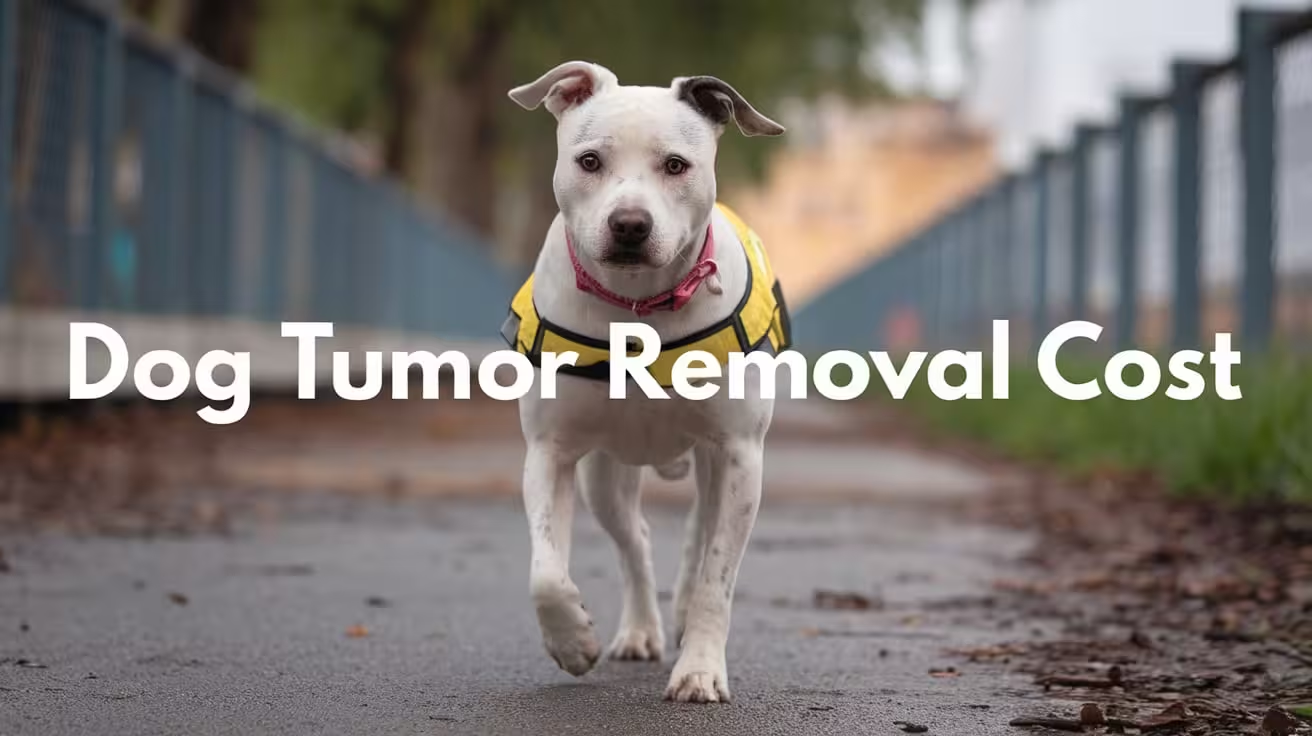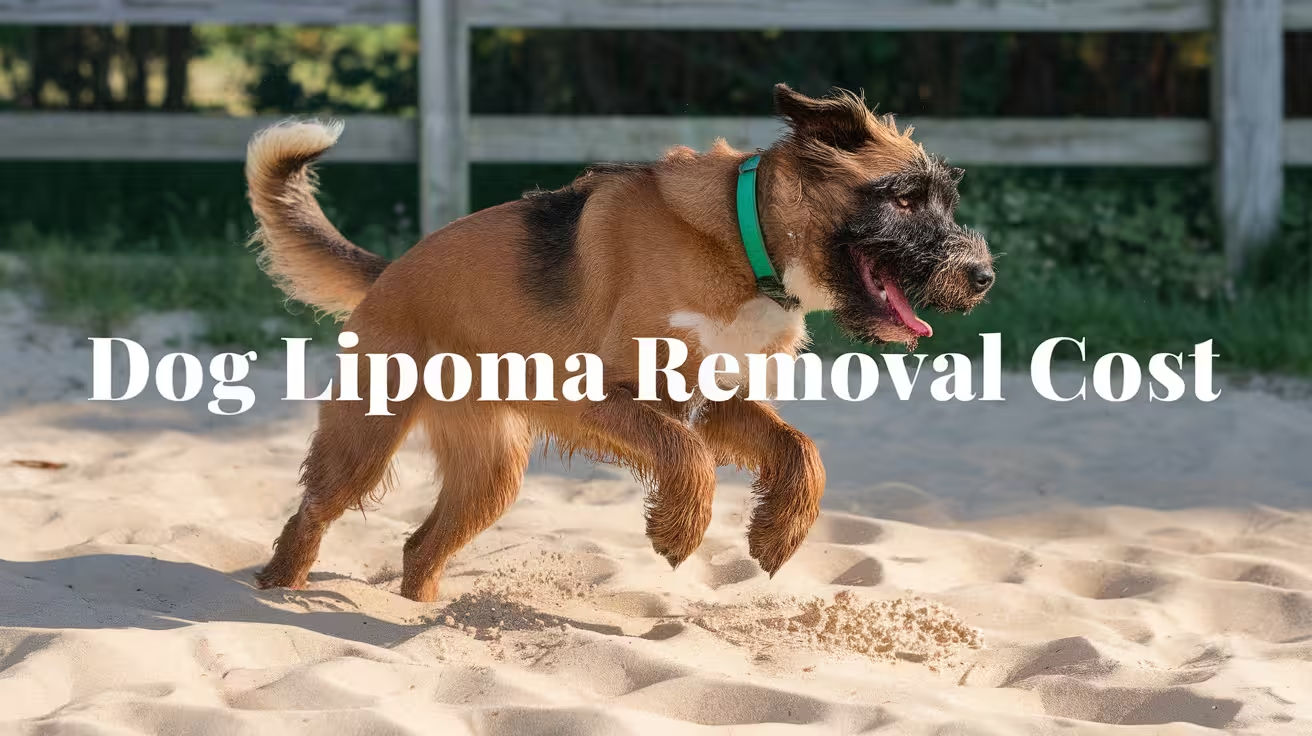Dog Tumor Removal Cost: What Owners Should Know
Learn how much dog tumor removal costs, what affects the price, and how to plan for surgery, recovery, and vet care expenses.

Understanding Dog Tumor Removal and Its Cost
A tumor in dogs is an abnormal growth of cells that can be either benign (non-cancerous) or malignant (cancerous). Unlike fatty lipomas, some tumors can invade nearby tissues or spread to other organs, making early detection and removal essential. Surgical removal helps diagnose the tumor type and prevents further health complications.
- Benign vs. Malignant Tumors: Benign growths are usually localized, while malignant tumors can spread rapidly.
- Why Removal Is Needed: Surgery may be curative, diagnostic, or preventive, depending on the tumor’s behavior and location.
- Cost Variation: Dog tumor removal costs vary widely from $300 for small skin tumors to several thousand dollars for internal or complex surgeries.
Understanding these basics helps owners plan both medically and financially.
Average Cost of Dog Tumor Removal Surgery
The cost of dog tumor removal varies depending on tumor type, location, and surgical complexity. Some tumors are simple skin growths, while others require advanced procedures involving imaging, specialized anesthesia, or reconstructive surgery.
- Minor Tumor Removal: Small surface tumors on the skin or eyelid usually cost between $300 and $800, including anesthesia and basic pathology.
- Moderate Surgeries: Tumors on the limbs, under the skin, or in sensitive areas like the mouth often cost $1,000 to $2,500 because of deeper tissue involvement and longer surgical time.
- Major or Internal Tumors: Complex cases involving organs such as the spleen, liver, or lungs can range from $3,000 to $7,000 or more, depending on post-op hospitalization.
- National Average Range: Across the U.S., the average cost for tumor removal, including vet consultation and anesthesia, is typically between $800 and $2,500.
This wide range reflects the variation in surgical difficulty, recovery needs, and the diagnostic steps involved.
Factors That Affect Dog Tumor Removal Cost
Tumor removal costs depend on several medical and logistical factors. Each element, from tumor type to the clinic’s expertise, influences both surgical complexity and overall pricing.
- Type of Tumor: Benign tumors like adenomas are easier and cheaper to remove than malignant cancers, which may require wide excision and advanced testing.
- Tumor Location: Growths on the skin surface cost less to treat than internal tumors affecting the abdomen, chest, or organs.
- Size and Number of Tumors: Multiple or large tumors increase anesthesia time, surgical effort, and lab testing costs.
- Diagnostic Needs: Biopsies, X-rays, ultrasounds, or CT scans are often required to evaluate spread, adding $200–$1,000 to the total bill.
- Clinic Type and Expertise: Specialty hospitals or board-certified surgeons typically charge higher fees for complex or high-risk cases.
- Dog’s Health Condition: Dogs with heart, kidney, or respiratory issues may need extra monitoring or tailored anesthesia, raising overall cost.
Each of these factors helps determine the most accurate estimate for your dog’s surgery.
Cost Breakdown: What’s Included in Dog Tumor Removal Surgery
Dog tumor removal involves several stages — from diagnostics to post-operative care. Understanding each cost component helps owners see what their payment truly covers.
- Pre-Surgery Diagnostics: Blood tests, fine-needle aspiration, or imaging confirm the tumor’s nature and assess surgical safety.
- Surgical Procedure: Costs include anesthesia, excision, surgical staff, and necessary monitoring equipment. Deeper tumors may require longer operative times and special tools.
- Lab and Pathology Fees: Removed tissue is sent for biopsy or histopathology to confirm whether the tumor is benign or malignant.
- Post-Operative Care: Pain medication, antibiotics, and wound care supplies are included to ensure proper recovery.
- Follow-Up Visits: Rechecks for healing and suture removal are part of aftercare, and additional testing may be required if malignancy is confirmed.
This breakdown ensures transparency and helps you prepare for both the surgery and follow-up stages without unexpected costs.
When Dog Tumor Removal Is Urgent vs Optional
Not all tumors require immediate surgery. Some grow slowly and can be safely monitored, while others pose urgent medical risks. Recognizing which situation applies helps you make timely, informed decisions.
- Signs of Urgency: Rapid tumor growth, bleeding, ulceration, foul odor, or visible pain when touched indicate the need for prompt removal.
- Location Concerns: Tumors that interfere with movement, breathing, or eating are considered emergencies and should be removed before complications develop.
- Aggressive or Malignant Tumors: If biopsy results show malignancy, early surgery improves prognosis and reduces the chance of spread.
- When Monitoring Is Safe: Small, stable, or benign masses can often be observed with regular vet checkups and measurement tracking.
- Risks of Delay: Waiting too long may allow malignant cells to spread, increasing surgical difficulty and cost later.
Your veterinarian’s evaluation helps determine whether removal is urgent or if observation remains a safe, short-term option.
Post-Surgery Recovery and Aftercare Costs for Dog Tumor Removal
Recovery from tumor removal surgery depends on the tumor’s type, size, and surgical complexity. Post-operative care is crucial to prevent infection, control pain, and promote healing, and it can add to the total cost.
- Typical Recovery Period: Most dogs recover within 10–14 days for small tumors, while major internal surgeries may require 3–4 weeks of restricted activity and monitoring.
- Pain Management: Pain-relief medications and anti-inflammatories usually cost $30–$100 depending on the dosage and duration.
- Antibiotics and Wound Care: Post-surgery antibiotics prevent infection and cost around $20–$60. Owners must keep incisions clean and prevent licking or scratching with an e-collar.
- Hidden Costs: Follow-up appointments, suture removals, and bandage changes can add $50–$200. Additional lab tests or biopsy reviews may increase expenses if complications arise.
- Rehabilitation for Major Surgeries: Some cases benefit from physiotherapy or laser therapy to restore mobility after tumor removal near joints.
Proper aftercare reduces complications and ensures faster recovery while minimizing long-term medical costs.
How to Budget for Dog Tumor Removal Surgery
Financial planning is essential before scheduling tumor removal, as costs can vary widely between general clinics and specialist hospitals. Knowing what to ask and how to prepare helps prevent surprises.
- Request a Detailed Estimate: Ask your vet for a full written quote covering anesthesia, diagnostics, pathology, and aftercare so you understand the total cost.
- Compare Providers: General veterinarians are often more affordable, while board-certified surgeons may charge more for complex or high-risk procedures.
- Pet Insurance Coverage: Most plans cover tumor removals if the mass wasn’t diagnosed before the policy started. Check for deductibles and exclusions.
- Payment Plans and Financing: Many clinics partner with financing companies or offer in-house installment options for expensive surgeries.
- Additional Savings Tips: Combining multiple tumor removals in one procedure can reduce anesthesia costs and overall fees.
A clear financial plan ensures your dog receives timely treatment without financial strain or unexpected costs after surgery.
Alternatives and Long-Term Management of Dog Tumors
Not all tumors require surgery, and some can be managed through observation or supportive care. Long-term management focuses on early detection, lifestyle improvements, and preventive veterinary follow-ups.
- Non-Surgical Options: Benign tumors such as sebaceous adenomas or small lipomas can sometimes be treated with cryotherapy or laser removal at lower costs.
- Lifestyle and Diet: A balanced diet rich in antioxidants and omega-3 fatty acids supports immune health and may slow tumor growth.
- Weight and Exercise: Maintaining ideal body weight reduces inflammatory stress and supports better healing after any surgical intervention.
- Monitoring Guidelines: Regular veterinary exams and at-home checks help detect new growths early, especially in older dogs prone to multiple tumors.
- Owner Awareness: Photograph and measure existing lumps monthly to track changes in size, color, or texture.
Long-term vigilance and proactive lifestyle care help reduce recurrence risk and improve overall well-being for dogs prone to tumors.
Conclusion
Dog tumor removal costs depend on many factors, including the tumor’s size, location, and whether it’s benign or malignant. Early diagnosis can often reduce surgical complexity and overall expense.
- Major Cost Drivers: Diagnostic tests, anesthesia, surgeon expertise, and post-operative care.
- Importance of Timely Action: Treating tumors early prevents spread, lowers costs, and improves recovery outcomes.
- Veterinary Consultation: A trusted veterinarian can assess whether immediate removal or monitoring is appropriate for your dog.
- Balanced Decision-Making: Combine medical priorities with financial readiness by exploring insurance, financing, or low-cost options.
When guided by professional advice and realistic budgeting, tumor removal becomes a manageable step toward protecting your dog’s comfort and long-term health.
FAQs
What is the average cost to remove a dog tumor?
The average cost of tumor removal ranges from $800 to $2,500, depending on the tumor’s size, depth, and location. Small skin tumors are less expensive, while complex surgeries for internal or malignant tumors can cost $3,000 or more, especially if hospitalization and advanced imaging are required.
Why do some tumor removals cost more than others?
Costs rise with surgical difficulty, tumor location, and pre-surgery testing. Internal tumors or those near vital organs need advanced imaging, skilled surgeons, and longer anesthesia time, all of which increase the price. Clinics with specialized facilities may also charge higher fees for complex cases.
Is pet insurance likely to cover tumor surgery?
Yes, if the tumor wasn’t diagnosed before your policy began. Most comprehensive pet insurance plans cover surgery, anesthesia, and pathology tests for tumor removals. However, pre-existing tumors or recurring cases are usually excluded, so review your policy’s coverage limits and waiting periods.
Can tumors come back after removal?
Some tumors can recur, especially malignant or infiltrative types. Even after clean surgical margins, microscopic cancer cells can regrow. Regular post-surgery checkups and imaging help detect any recurrence early and ensure timely intervention to maintain long-term health.
Are there low-cost clinics for tumor surgery?
Yes, many animal welfare organizations, veterinary schools, and community clinics offer discounted surgical programs. While availability varies by region, these options help pet owners manage expenses without compromising on essential care or surgical safety standards.

Get a Free Poster
Enhance your workspace with a high-quality radiographs reference poster, designed for veterinary professionals. This free physical poster will be shipped directly to you—just fill out the form to request your copy.
Step #1
Getting Ready
Ensuring a clean surgical field starts with proper skin preparation. This video demonstrates the best practices for:
- Shaving the patient – Achieving a close, even shave while minimizing skin irritation
- The Dirty Scrub – The initial skin prep step to remove surface debris and reduce bacterial load before the sterile scrub.
Following these techniques helps reduce infection risk and improve surgical outcomes. Watch the video to see how it’s done effectively!
Step #2
Reduce Your Risks
Many surgeons are shocked to find out that their patients are not protected from biofilms and resistant bacteria when they use saline and post-op antibiotics.
That’s Where Simini Comes In.
Why leave these risks and unmanaged? Just apply Simini Protect Lavage for one minute. Biofilms and resistant bacteria can be removed, and you can reduce two significant sources of infection.
Step #3
Take the Course
Preventing surgical infections is critical for patient safety and successful outcomes. This course covers:
- Aseptic techniques – Best practices to maintain a sterile field.
- Skin prep & draping – Proper methods to minimize contamination.
- Antibiotic stewardship – When and how to use perioperative antibiotics effectively.
Stay up to date with the latest evidence-based protocols. Click the link to start learning and earn CE credits!













